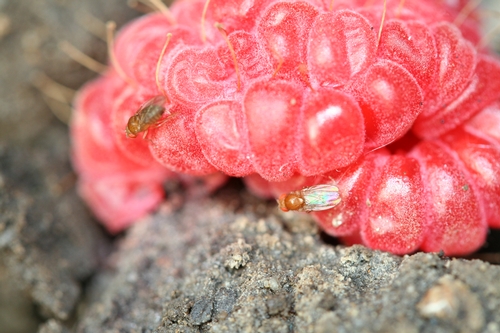A rather thorough presentation of one year’s worth of work on spotted wing drosophila was made at the big entomology meeting on September 13. As this presentation will not be posted anywhere, the following will be a summary of the work and what we know so far, along with some pointers that may be useful for growers to follow in their efforts to control this pest.
Along with various private industry efforts, the work that is being done right now by UC Davis and UCCE on spotted wing drosophila is important. The California caneberry industry is 56% of the national fresh market production and has a production cycle on the Central Coast starting in April and continuing on until December, creating a situation of considerable potential of economic harm for this pernicious pest.
The trapping portion of this study tested two common bait formulations, yeast + sugar + water and apple cider vinegar, against a water control from late October 2010 to early September 2011. We are still in the first year of the study so it is a bit early to draw conclusions, but over time the yeast + sugar + water perhaps performed a little better than the apple cider vinegar. Both baits tended to follow the same pattern meaning there was a period of no response to the traps (they caught very few adult flies) from late February to late May and a large increase of adult flies in the late season. Additionally, there tended to be more females trapped than males. Whether this is a function of there simply being more females in the field than males or that the traps are simply more attractive to females remains something to be investigated.
Sampling for larvae which began mid-May of this year seems to indicate the first generation of larvae may appear before any noticeable adult fly population, and this continues later on through the season as larval peaks correlate with adult population peaks. Larval and adult fly populations peak after the end of harvest, which only underlines that growers remove the crop as soon as possible after the cessation of fruit production.
A remaining target for us is the whereabouts of the population of spotted wing drosophila during the period of no response to traps (late February to late May). We are not trapping flies in the fields, but obviously they start to come from somewhere when the season gets underway again in the spring. We must understand what is going on here, as these stages of low pest activity tend to historically be the areas where the strongest measures of integrated pest management can be applied.
Attached Images:

Drosophila on fallen raspberry fruit